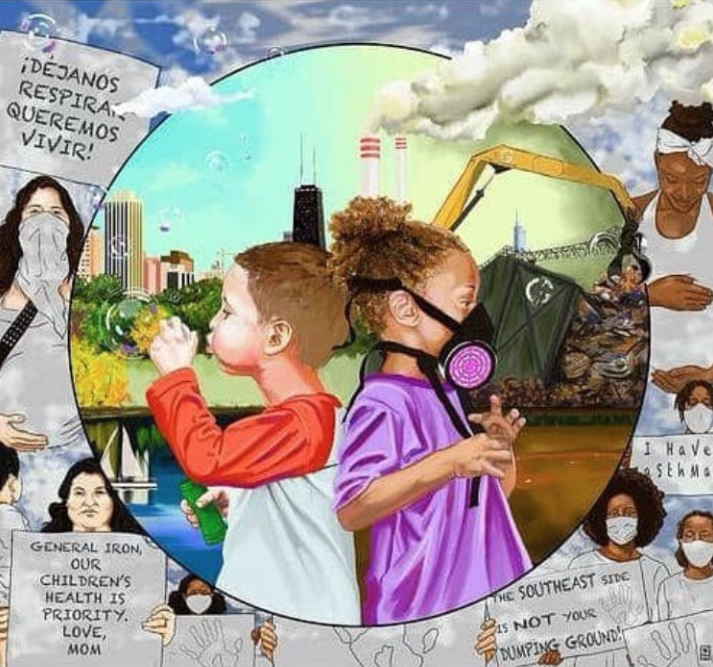March 4th marked the end of a month-long hunger strike by activists opposing the pending move of General Iron, a metal scapper, to the Southeast Side. Opposition has been building since 2018 when the company announced its plans to move from its current location at 1909 N. Clifton Ave. in the affluent, majority-white Lincoln Park neighborhood, where residents organized to oust the polluting industrial land use, to 11600 S. Burley Ave. in the East Side community, a blue collar neighborhood that's majority-Latinx.
The strike was originally started by Breanna Bertacchi, Chuck Stark and Óscar Sánchez on February 4, and in the weeks following they were joined by eight others, including Alderman Byron Sigcho-Lopez (25th), according to a Block Club report by Colin Boyle and Maxwell Evans. Over 100 Chicagoans protested near Mayor Lori Lightfoot’s Logan Square home last Thursday night to stand up for environmental justice.
On the surface a metal recycling plant sounds relatively innocuous. But for Southeast Siders the move represents another threat to their respiratory health. Last year the Chicago Department of Public Health released an Air Quality and Health report showing that low-income, Black and Latinx communities on the South and West sides are disproportionately impacted by air pollution. Regarding the General Iron issue, Dr. Susan Buchanan, a public health professor at the University of Illinois at Chicago, recently told the Guardian, “The particulate matter that typically emanates from these facilities can cause severe respiratory and cardiovascular conditions."
The city of Chicago announced an air quality “reform agenda” last July. The agenda includes an ordinance requiring the city to consider an area’s existing air pollution burden before adding new polluting land uses, and the creation of an environmental equity advisory group.
However, an advisory group is not a remedy for the problem of environmental racism. Looking at how the Lightfoot administration and previous Chicago mayors have treated community input, I am highly skeptical that an advisory group will have a substantial influence to effect change. The most glaring example of Chicago residents’ voices not being heard is the recent 2021 budget survey in which respondents overwhelmingly stated that they wanted fewer city funds going towards police and more funds going towards social services. In the end, there was very little shift in funding from police to social services. Outcomes like this erode the public’s trust that city officials care about their opinions.
While the city has promised more regulations on General Iron in its new home, many East Side neighbors questioned whether more rules are the right strategy, since the company has violated regulations in the past. The city implemented new rules for metal recyclers in response to lobbying from Lincoln Park residents upset about General Iron. Those regulations include air impact and traffic studies, monitoring of particulate matter, and real-time notification if an issue arises, plus a plan to mitigate health impacts, and stricter record-keeping.
The City Council approved an ordinance last January that would impose larger fines on large industrial companies and demolition contractors that violate air pollution standards. However, these fines seem like a slap on the wrist or an added cost of doing business. The longterm solution is to move toxic industry out of population centers like Chicago.
Last April Streetsblog Chicago noted that the Crawford power plant demolition, which created a ten-block radius cloud of brown dust on Chicago’s Southwest Side, making it difficult to see, breathe, walk, or ride a ride, was a mobility justice issue. General Iron’s desire to do business in the city of Chicago and the relative permissiveness of state and city departments to allow their toxic work to continue is a mobility justice issue as well. Our city's and state’s land-use patterns and regulatory practices must be reformed to eliminate environmental racism. I noticed during the Cook County Bike Plan open house some of the participants who lived on the South Side mentioned how much heavy industry impacts their ability to bike. I also noted when the presenter pointed out barriers to creating safe bike infrastructure due to heavy industry and/or truck traffic on the South Side.
Along with shifting land use patterns, we must also demand that industry begin to transition away from toxic materials and practices that threaten human and environmental welfare. Communities most impacted by environmental racism should be charting their own path towards a just transition and a just recovery from the impacts of decades of environmental abuse and neglect. It's long past time to listen to the voices of those bearing the brunt of environmental racism. #DenyThePermit




